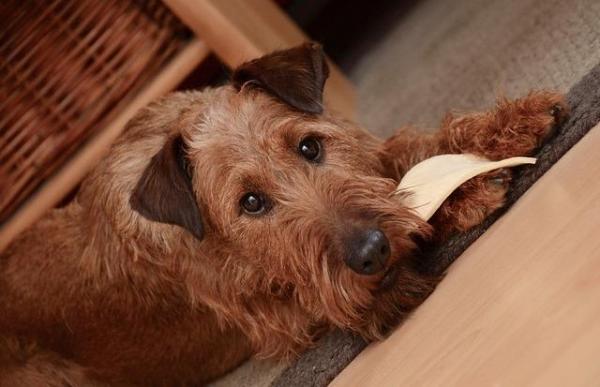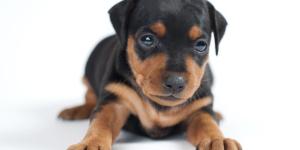How to Feed a Malnourished Dog


When a dog is malnourished or thin, it needs a greater amount of protein and fat, that should be followed by a balanced diet. You should not make the mistake of overfeeding your pet if it does not eat for a few days because it's stomach will be more susceptible to being stretched and could cause serious damage. Follow a series of guidelines to notice an improvement in giving food to your malnourished dog. In this OneHowTo.com article, we'll explain how to feed a malnourished dog.
What to do with an emaciated dog to regain health
There are many reasons why a dog can become malnourished or too skinny. Sometimes when a dog is lost or has been abandoned it might go several days without eating, reducing weight dramatically. The dog may also suffer from some disease or parasites that prevents it from eating and being at its optimum weight. Other times, it can be very thin due to some kind of nervous disorder. Whatever the cause, when your dog does not eat its blood sugar levels decrease. This decrease in glucose can seriously affect your dog's body, impairing the function of the brain, kidneys, heart and muscles.
Malnutrition will worsen over time. On the third day of not eating anything, your pet's metabolism will slow down and, on the fifth day, its fat reserves will be their only source of energy. This is why, if you find an emaciated dog with malnutrition, it's important to examine them first in order to assess why the dog is malnourished:
- Check for any visible infections in eyes, paws, mouth and tongue which may be preventing the dog from eating. In this case, it's advisable to feed the dog as explained below while curing these infections for the dog to fully recover. The color of their gums can also indicate anemia, whereas red or pinkish eyes may also indicate the dog needs urgent veterinary treatment.
- You will need to palpate the dog's abdomen area to look for any signs of intestinal damage. To do so, use both your fingertips on your left hand on the left abdomen, while your left hand is placed under the belly. Push several areas while bringing your hands together and look for signs of pain. Be careful while doing this if the dog growls or shows signs of aggression.
- Check for signs of Valley Fever if you live in the American continent, as this is one of the main symptoms of this disease.
- Check for signs of dehydration such as vomiting, diarrhea, and its skin will not go back to place immediately if the skin on the lower part of its neck is pinched.
The first thing to do after assessing all these things is to give the dog some water. If it shows interest in drinking, you can proceed in feeding them. If not, the malnourished dog may need veterinary attention.

Feed a malnourished dog yourself
One essential point to note when you feed a malnourished dog is that you should dish out the meals yourself. You must not allow your dog to have free access to food and let him freely eat for the first few days after having gone without food for a time. This could have serious problems for digestion. It is recommended that you feed your dog small portions every 6 hours, so that it eats four times per day. When your dog's stomach has gone through a period of no food, it will shrink and become more susceptible to stretching when it starts to eat again. This sensitivity to expansion usually disappears in about five days if you follow the guidelines of feeding a malnourished dog gradually and in sensible portions, shared out throughout the day. When feeding a malnourished dog, avoid giving it one large meal to last the whole day. This is very harmful and dangerous.
If the dog refuses solid food, try giving them unsalted chicken broth. This will be a good start to recovery, giving them the essential nutrients they need.
The amount of food you feed an emaciated dog
Given the importance that your malnourished dog is well fed, we'll point out something that you should avoid doing. If your dog is too thin, do not give in to the urge to feed it coious amounts. Overfeeding your pet is wrong; you'll have to gradually increase it to prevent it from being too full. It is recommended that you control its pace of eating to ensure that there is no problem.
Another of the tips when it comes to feeding your dog is to be very careful with the amount of food that you provide daily. The dose should be adjusted in accordance with its weight; therefore, note its consumption of food and make sure it eats the right quantity that's adequate and necessary to nourish our dog back to good health. While you're checking its new eating habits, you should weigh your pet every week and control its weight. This will help you keep track of its weight until it regains the kilos it has lost.
How can you calculate how much a malnourished dog should eat? This will depend on the size and breed of the malnourished dog as well as its age, which is why at oneHOWTO we'd like to give you a formula so you can calculate it yourself:
- First of all, you should know that the amount of food you feed an emaciated dog is calculated in amount of calories, so this will depend on the brand of high quality food you're feeding them.
- Use the Resting Energy Requirement table to calculate it. The formula is (30 x the dog's body weight in kilograms) +70.
- Once you have the RER figure, you'll need to multiply it by its weight gain multiplier, which is 1.7.
- For example, if your malnourished dog weighs 5 kg, the formula should be: (30 x 5) +70= 220, 220 x1.7= 374 kcal/day
- The result will give you the amount of kilo-calories the dog needs per day.

What to feed and underweight dog
To ensure that your malnourished dog recovers and regains weigh after going without food for one week, it is recommended that the diet be composed primarily of fat, keeping the carbohydrates proportionally low. It should also have optimal amounts of minerals such as magnesium, potassium and phosphorus.
You must consider the amount of calories in the food that your dog eats during this delicate phase. The calories consumed should be the same as your dog eats under normal circumstances. You should also make sure it has free access to water in order to stay well hydrated. A 15% loss of water could be fatal to your dog.
If your dog reaches this stage, it may start refusing food. If it does not eat dry feed, try mixing it with wet food to make it more palatable. However, avoid feeding it too much wet food because they contain much more water than protein and fat, and should not be the main component of their diet.
One of the main ingredients in the diet of a malnourished dog should be turkey, lamb, and chicken or any other kind of meat that they like. Provide your pet with high-quality food with an average fat content of at least 18% and between 25 and 30% of protein. To put weight on an emaciated dog, it needs to be fed a greater percentage of fat, and it should be simple to incorporate these changes to its diet for a few days You can feed it nutritious food like egg, dairy products and cooked boneless meat.
Apart from the dog's food it's important to add nutrient supplements to their diet. Omega-3 and Omega-6 supplements will give your dog the amount of fatty acids it needs to recover.
What to do if the malnourished dog won't eat
Finally, if your malnourished dog still refuses to eat despite your efforts, if your dog won't eat the full amount it is meant to consume per day, you should take them immediately to the vet as they may be suffering from a nervous disorder. If your dog is not eating as a result of a problem of this kind, the most important thing is to balance its internal chemistry. You will have to treat your dog's nervousness as soon as possible so that it starts to eat normally. If this is the case, go to the vet immediately or a canine behavior specialist for evaluation, treatment and to get your dog to start eating normally today.

If you want to read similar articles to How to Feed a Malnourished Dog, we recommend you visit our Pets category.
Tips
- Take your dog if you notice blood in the dog's stool or vomit.







